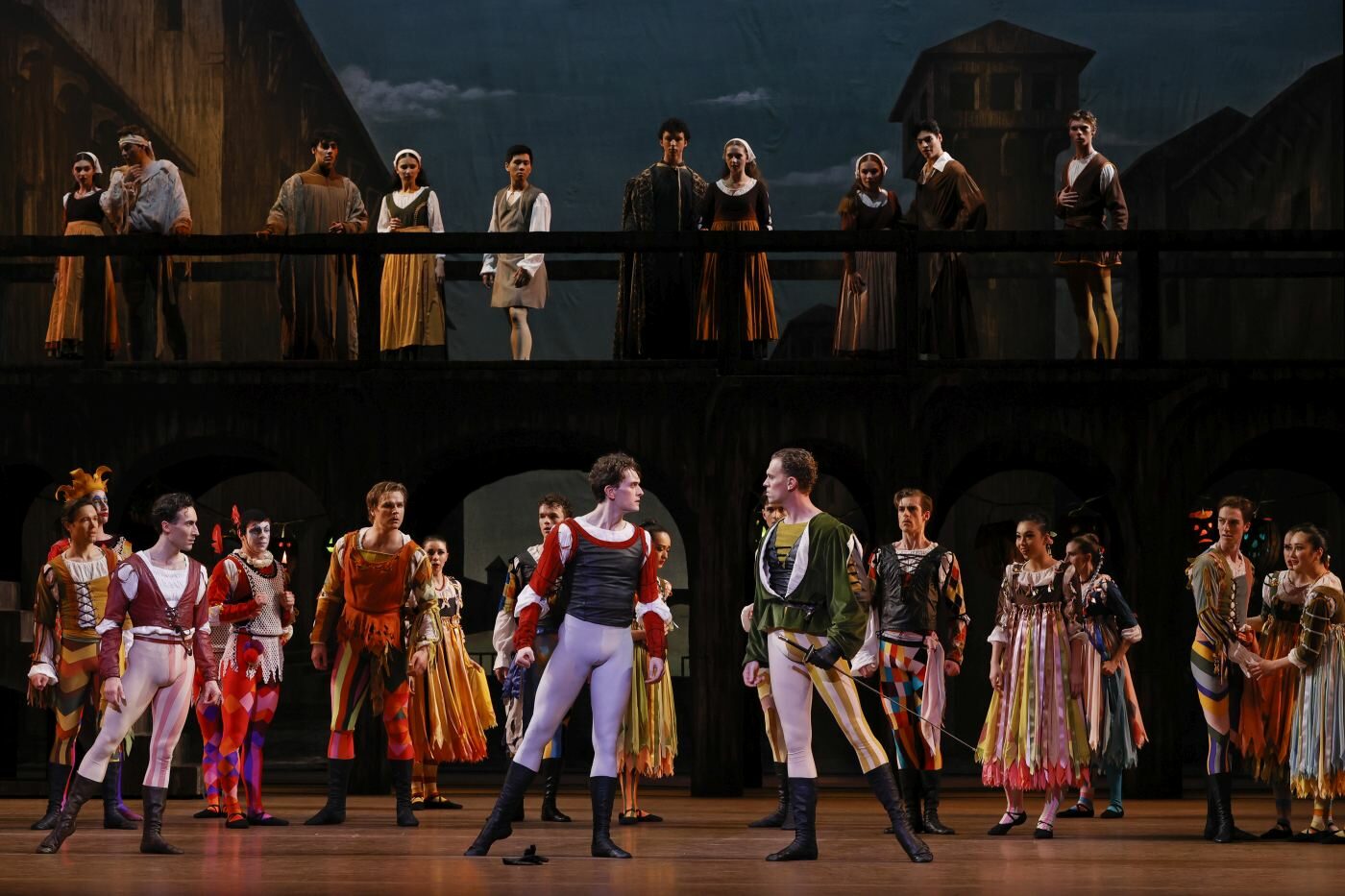“Positioning Ballet”
Dutch National Ballet
Dutch National Opera & Ballet
Amsterdam, The Netherlands
February 11-12, 2017
by Ilona Landgraf
copyright © 2017 by Ilona Landgraf
 To discuss fundamental topics concerning the art form of ballet, the Dutch National Ballet assembled a keenly interested, much involved, very international group of guests for a two-day conference last weekend in Amsterdam. At the Saturday session, panel discussions addressed three topics: Heritage, Diversity and Identity. Of the two Sunday morning talks, one focused on networking among companies, and the other advocated inventive entrepreneurship. There was a performance both days, each a mixed bill with works which had been made for the Dutch company (see my reviews of “Made in Amsterdam 1” and “Made in Amsterdam 2”).
To discuss fundamental topics concerning the art form of ballet, the Dutch National Ballet assembled a keenly interested, much involved, very international group of guests for a two-day conference last weekend in Amsterdam. At the Saturday session, panel discussions addressed three topics: Heritage, Diversity and Identity. Of the two Sunday morning talks, one focused on networking among companies, and the other advocated inventive entrepreneurship. There was a performance both days, each a mixed bill with works which had been made for the Dutch company (see my reviews of “Made in Amsterdam 1” and “Made in Amsterdam 2”).
Participants
Among the approximately 120 conference participants were the artistic directors of major companies, choreographers, dancers, writers and others expert in the field of ballet and dance performance. The directors included: Nina Ananiashvili (State Ballet of Georgia), Marc Baldwin (Rambert), Kader Belarbi (Ballet du Capitole), Ted Brandsen (Dutch National Ballet), Roberto Casarotto (Ballet Roma), Janine Dijmeijer (Nederlands Dans Theatre), Tamas Detrich (Designate Director of Stuttgart Ballet), Yuri Fateyev (Maryinsky Ballet), Kenneth Greve (Finish National Ballet), Karen Kain (The National Ballet of 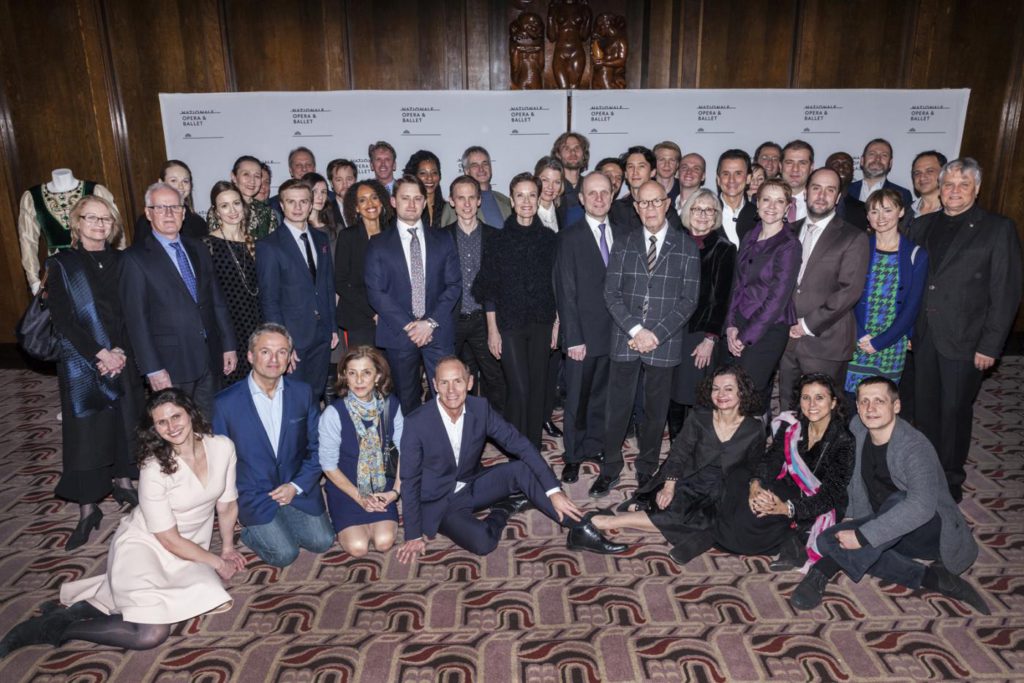 Canada), Julie Kent (The Washington Ballet), Aivars Laimanis (Latvian National Ballet), Ingrid Lorentzen (Norwegian National Ballet), Kevin McKenzie (American Ballet Theatre), Gennadi Nedvigin (Atlanta Ballet), Kevin O’Hare (The Royal Ballet), Johannes Öhman (Royal Swedish Ballet), Madeleine Onne (Hong Kong Ballet), Erik Pals (Scapino Ballet), Krzysztof Pastor (Polish National Ballet, Lithuanian National Ballet), Tamara Rojo (English National Ballet), Tamas Solymosi (Hungarian National Ballet), Alistair Spalding (Sadler’s Wells), Helgi Tomasson (San Francisco Ballet), Elena Tupyseva (Ballet Moscow) and Ashley Wheater (Joffrey Ballet).
Canada), Julie Kent (The Washington Ballet), Aivars Laimanis (Latvian National Ballet), Ingrid Lorentzen (Norwegian National Ballet), Kevin McKenzie (American Ballet Theatre), Gennadi Nedvigin (Atlanta Ballet), Kevin O’Hare (The Royal Ballet), Johannes Öhman (Royal Swedish Ballet), Madeleine Onne (Hong Kong Ballet), Erik Pals (Scapino Ballet), Krzysztof Pastor (Polish National Ballet, Lithuanian National Ballet), Tamara Rojo (English National Ballet), Tamas Solymosi (Hungarian National Ballet), Alistair Spalding (Sadler’s Wells), Helgi Tomasson (San Francisco Ballet), Elena Tupyseva (Ballet Moscow) and Ashley Wheater (Joffrey Ballet).
Heritage
Peggy Olislaegers (internationally working Dance Dramaturge) moderated the program.
After welcoming words by Kajsa Ollongren (an Alderperson and the Deputy Mayor of Amsterdam), Wiebke Hüster (Dance Critic and Writer from Germany), gave the keynote speech: Heritage. She mentioned many issues but was often off-topic, long winded and unstructured. She held forth about the work overload faced by choreographers, the little time they have to read and research, and the huge pressure on them to produce something new. One the one hand, Hüster saw no need for a steady stream of fresh work; on the other, she lamented the lack of new narrative ballets and choreographers’ disinterest in up-to-date topics: “Where is the choreographer doing a ballet on a Jonathan Franzen novel? Where are they? What are they doing when going home after rehearsal?”
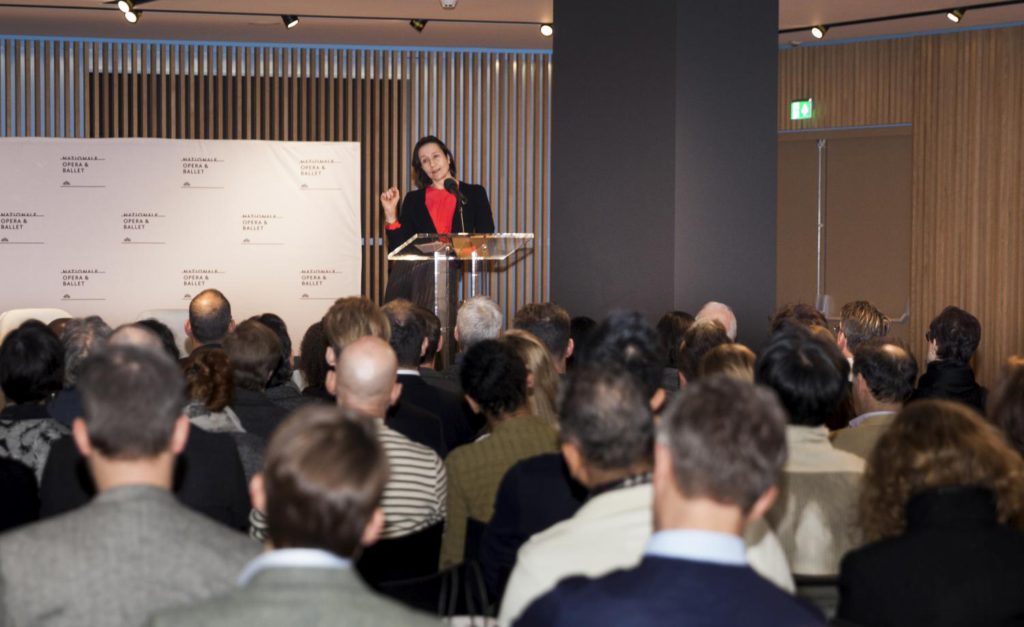 Hüster mentioned the benefits and limitations of basing a reconstruction on a notation of the original choreography. She raised questions about what defines a piece as a classic and about the criteria for selecting a repertory. For companies with a long tradition, like the Maryinsky, heritage has a different meaning than for companies shaped by the work of one choreographer, like New York City Ballet. Moreover, Hüster said that the latter sort might become problematic, citing the Martha Graham Dance Company, Merce Cunningham’s former company, Pina Bausch’s Tanztheater Wuppertal and John Cranko’s Stuttgart Ballet as examples. Stuttgart over and over again serves up “Swan Lake” and “Onegin” according to Hüster but neglects Cranko’s other pieces. I don’t know when last she was in Stuttgart , but she seems to have overlooked “Romeo and Juliet” and “Shrew”. Also, Cranko’s “Swan Lake” hasn’t been scheduled since 2012. Only last season that company revived “Poème de l’Extase”, “Concerto for Flute and Harp”, “Holberg Pas de Deux”, “Opus 1” and “Initials R.B.M.E.” – all by Cranko! I assume her complaint about the year-long absence of Balanchine’s “Apollo” referred to companies in Germany. She could have seen it in Dresden in early 2013, danced by the Semperoper Ballet.
Hüster mentioned the benefits and limitations of basing a reconstruction on a notation of the original choreography. She raised questions about what defines a piece as a classic and about the criteria for selecting a repertory. For companies with a long tradition, like the Maryinsky, heritage has a different meaning than for companies shaped by the work of one choreographer, like New York City Ballet. Moreover, Hüster said that the latter sort might become problematic, citing the Martha Graham Dance Company, Merce Cunningham’s former company, Pina Bausch’s Tanztheater Wuppertal and John Cranko’s Stuttgart Ballet as examples. Stuttgart over and over again serves up “Swan Lake” and “Onegin” according to Hüster but neglects Cranko’s other pieces. I don’t know when last she was in Stuttgart , but she seems to have overlooked “Romeo and Juliet” and “Shrew”. Also, Cranko’s “Swan Lake” hasn’t been scheduled since 2012. Only last season that company revived “Poème de l’Extase”, “Concerto for Flute and Harp”, “Holberg Pas de Deux”, “Opus 1” and “Initials R.B.M.E.” – all by Cranko! I assume her complaint about the year-long absence of Balanchine’s “Apollo” referred to companies in Germany. She could have seen it in Dresden in early 2013, danced by the Semperoper Ballet.
Scheduling familiar classics like “The Sleeping Beauty” only because they succeed at the box office is disgusting according to Hüster. She asked for alternatives to attract the audience.
Admittedly, Hüster declared that she intended to be provocative, but that would have required preparation in depth. Some visuals, such as Power Point examples or film clips, would have helped her to hammer down her points.
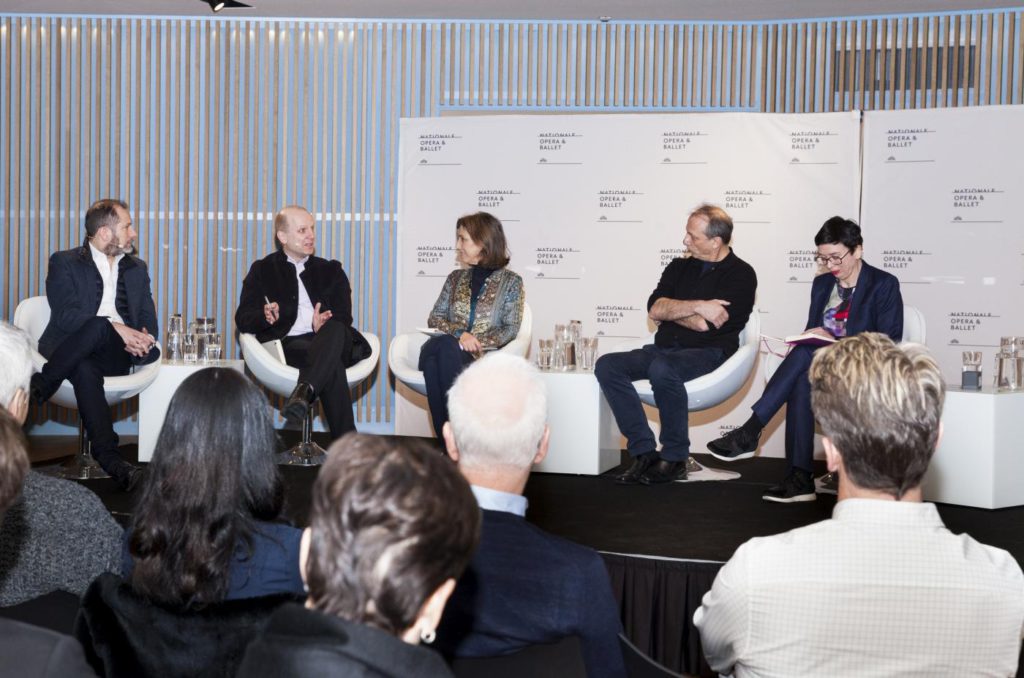 The panel which discussed Heritage further included Yuri Fateyev, Kevin O’Hare, Krzysztof Pastor and Luísa Taveira (Founding Member of the National Ballet of Portugal, and Member of the Board of Directors of the Foundation Centro Cultural de Belém), and there were participants from the audience. Yet a true conversation didn’t develop because Olislaegers repeatedly interrupted those speaking, sometimes in the middle of a sentence, in order to counter question, summarize or turn the floor over to someone else if the speaker didn’t meet her expectations. She acted like a teacher testing students. At this session Fortunately, Olislaegers was more restrained during the following panels.
The panel which discussed Heritage further included Yuri Fateyev, Kevin O’Hare, Krzysztof Pastor and Luísa Taveira (Founding Member of the National Ballet of Portugal, and Member of the Board of Directors of the Foundation Centro Cultural de Belém), and there were participants from the audience. Yet a true conversation didn’t develop because Olislaegers repeatedly interrupted those speaking, sometimes in the middle of a sentence, in order to counter question, summarize or turn the floor over to someone else if the speaker didn’t meet her expectations. She acted like a teacher testing students. At this session Fortunately, Olislaegers was more restrained during the following panels.
Debate about heritage touched on the general repertory, the classics, curating, commissioning new pieces and preserving ballets for the future. The question, whether it is essential for a company to have and display any heritage at all, was quickly disposed of. “The big works of humanity must be shown. There is always a new generation, which hasn’t seen them”, said Taveira. Unlike Hüster’s assumption that classics are scheduled to bring in cash, O’Hare explained, that there are different reasons why The Royal Ballet does keep its annual “Nutcracker”. It attracts an audience that is around 40% new, it balances the repertory aesthetically and dancing the classics in general trains promising talent.
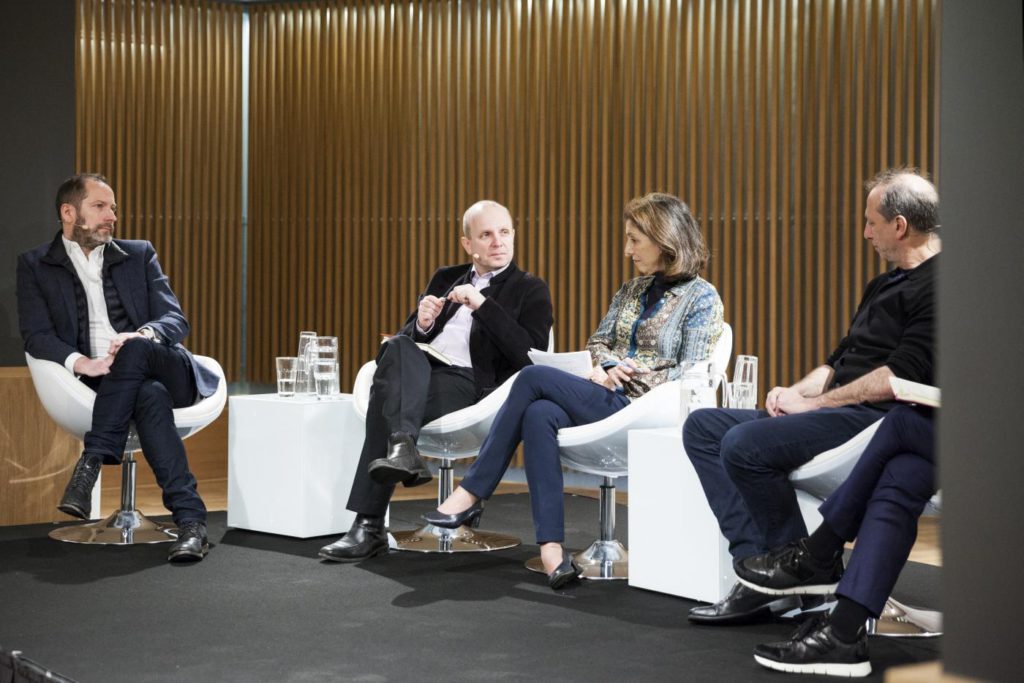 A recurring question throughout the discussion was “What defines a classic?”. Opinions varied. O`Hare thought that classics are pieces relevant for the company today, ones that suit the company. In the case of Britain’s Royal Ballet, he said that Ashton’s and MacMillan’s choreography and approaches define the nature of the company. Taveira said: “A classic is a piece that has the quality of surviving the changes of time until the present day.” The meaning of ‘classic’ for Mark Baldwin is ‘pure’, so creating classics is still possible today. Tamara Rojo’s definition was stricter: only those pieces which follow the canons of classicism are classics.
A recurring question throughout the discussion was “What defines a classic?”. Opinions varied. O`Hare thought that classics are pieces relevant for the company today, ones that suit the company. In the case of Britain’s Royal Ballet, he said that Ashton’s and MacMillan’s choreography and approaches define the nature of the company. Taveira said: “A classic is a piece that has the quality of surviving the changes of time until the present day.” The meaning of ‘classic’ for Mark Baldwin is ‘pure’, so creating classics is still possible today. Tamara Rojo’s definition was stricter: only those pieces which follow the canons of classicism are classics.
There was agreement that style, too, is part of the heritage. Yet style isn’t frozen in time and place. Taste has altered; the technique and the dancers’ physical abilities and bodies have changed. Hence, today’s “The Sleeping Beauty” can’t be identical with the original version at its time of creation. Nevertheless, huge effort has gone into reconstructions. Millicent Hodsen and Kenneth Archer have restitched Nijinsky’s “The Rite of Spring” together; Nikolai Sergeyev, Sergei Vikharev and Alexei Ratmansky among others have tried to restore Marius Petipa’s “The Sleeping Beauty” and Petipa and Lev Ivanov’s “Swan Lake”, etc.
The commissioning of new work, everyone agreed, is a huge responsibility. It is “essential to keep the young blood in the company”, according to Fateyev. “Young dancers want to dance something special, almost everyone dreams of a role created on them. […] But we also have to keep the face of the company.” Ideally, the chosen choreographer impacts the way the company works, as at The Royal Ballet when, for example, Hofesh Shechter, Crystal Pite or Wayne McGregor make new pieces on the dancers. Pite, and especially McGregor, know the London-based company well, but what about giving someone less familiar a chance? Does this newcomer need to relate to the company’s heritage? “Of course, we do converse with the choreographers, that is important, but whether the piece will be a success we won’t know until it’s onstage”, Fateyev stated, adding “But we’d always take a risk.” Pastor stressed that choreographers needed to be given optimal conditions in order to achieve good results. “They need to feel at home in the company.” Ideal conditions include freedom and, what is generally vital, time.
That led to the issue of curating. Olislaegers inquired repeatedly “How do you curate? What do you bring back?”, but it turned out that there is no rule, no catalog of criteria. Gut feeling and intuition count. What wasn’t well-received the first time might become a hit the next season. Irrespective of their initial success “commissions should come back. They need to have a life”, said O’Hare.
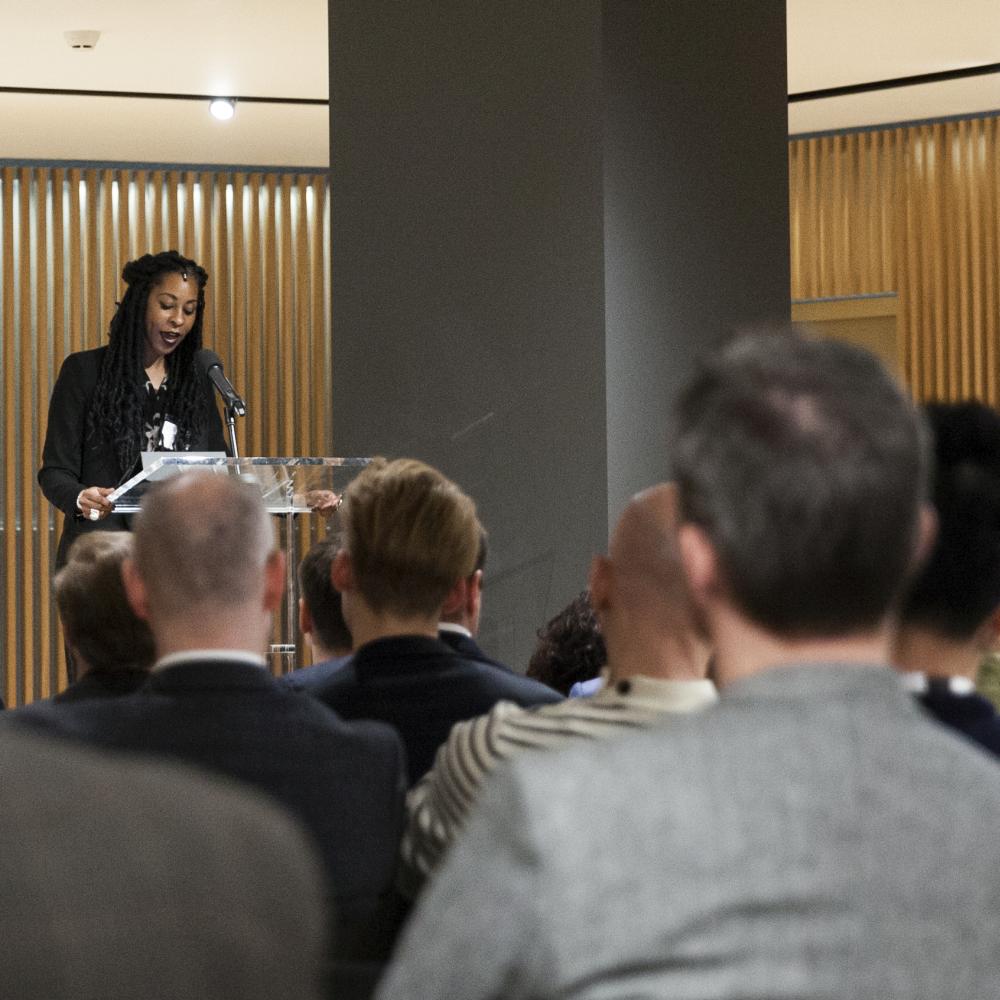 Diversity
Diversity
Theresa Ruth Howard (Emerita of Dance Theatre of Harlem and Founder of Mooallet.org [Memoirs of Blacks in Ballet]) was the keynote speaker for Diversity. Her speech was powerful, thought-provoking and thrilling.
“I was a ballerina and I’m still black”, Howard began. “Diversity is a hot topic around the world, but the discussion is circular. It keeps going but we’re ending up at almost the same position.” Why hasn’t the nerve of the problem been hit? “Under the auspices of political correctness we talk around the subject. We’re not afraid of offending, we’re afraid of the confrontation. We tend to intellectualize the subject, because when you stay in your head and disconnect from your heart you exclude the humanness from the issue and it becomes like a math problem we have to solve. […] At the root of this conversation is bias about racial, sexual, gender orientation issues. These biases are systemic and chronic […] People like to think that art reflects the best of humanity. Well, art is just the microcosm of it, formed in its image, reflecting the same values, just with sparkles.” Howard asked for empathy, for compassion and suggested to just listen and to entertain the possibility that there is a reality one has neither seen nor felt up to now.
Ballet originated in the courts of Europe as an elitist art form. When it became a representation of nationalistic pride the bodies of the dancers of the national companies carried that message. Hence, the companies looked like the people of that country. Things got tricky, however, in the course of colonization when people of color were mixed in. Why hasn’t the demographic change effected the faces of the companies? “The resistance to diversification or to integration is about maintaining an identity, a heritage, of pre-brownness. […] People of brown color were never supposed to be members of society, let alone be represented. Therein lies the whole problem.” Today’s generation didn’t create the problem, but inherits and perpetuates it by default. Artistic directors need to ask themselves whether their companies really represent the nation.
“As an African American ballerina, as an intellectual, articulate woman, I represent the exception and never the rule. This is how the victors wrote my character in history. […] The pressure of living in a black body is indescribable. Black ballet dancers carry the weight of our ways into the studio. Every pirouette, every arabesque represents our race’s collective ability to become professional ballet dancers. If one fails, doors close for others. […] Creating diversity is not hard. It does not cost money and you don’t need to draft an initiative. All you need to do is let people in.”
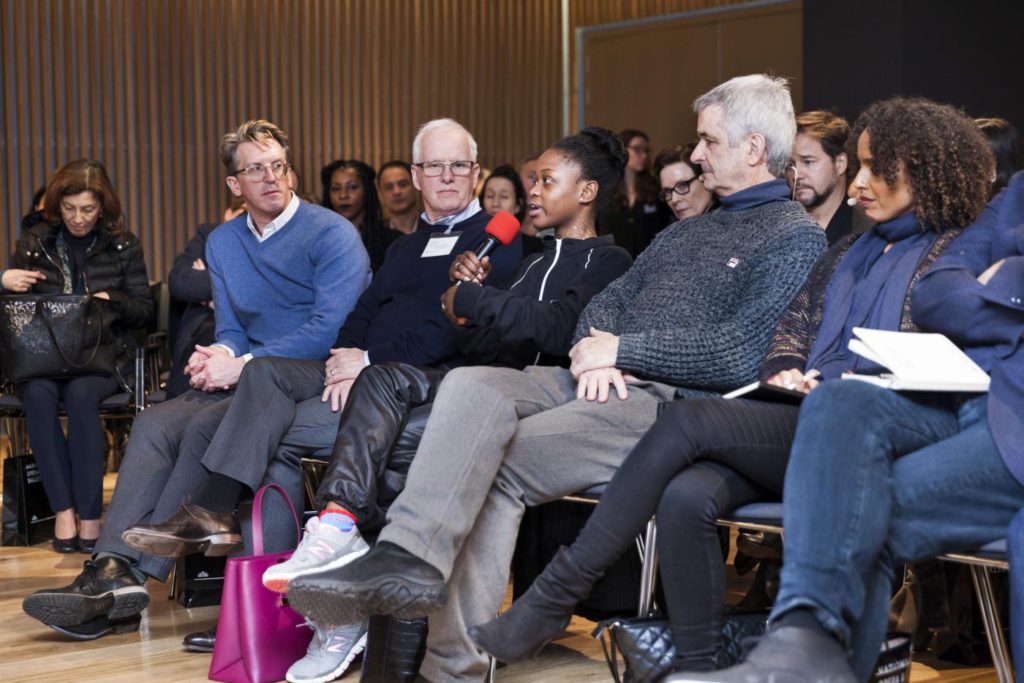 Before the panel members took their seats on the podium, Dutch National Ballet’s Michaela DePrince shared her experience of what it means to be a black dancer. She confirmed that being black has put pressure on her shoulders. “The fact that I inspire young girls to become ballerinas is a lot to handle but it’s also the reason for me to work harder. I’m lucky because my director is very, very supportive, enabling me to say no to an opportunity when the pressure would be too much. […] Most companies have white-skinned dancers and it’s quite hard, because you look at the corps the ballet and you see somebody who sticks out like a poppy in a field of daffodils. That’s distracting. But what happens if there were more poppies in that field of daffodils? Would that cause the same distraction? […] I think if we had more diversity it would look much better.”
Before the panel members took their seats on the podium, Dutch National Ballet’s Michaela DePrince shared her experience of what it means to be a black dancer. She confirmed that being black has put pressure on her shoulders. “The fact that I inspire young girls to become ballerinas is a lot to handle but it’s also the reason for me to work harder. I’m lucky because my director is very, very supportive, enabling me to say no to an opportunity when the pressure would be too much. […] Most companies have white-skinned dancers and it’s quite hard, because you look at the corps the ballet and you see somebody who sticks out like a poppy in a field of daffodils. That’s distracting. But what happens if there were more poppies in that field of daffodils? Would that cause the same distraction? […] I think if we had more diversity it would look much better.”
In the panel discussing Diversity were Monique Duuvoort (Emerita of Dutch National Ballet and Artistic Director and Choreographer of MDDance), Paul Liburd (Choreographer, Dance Teacher and Emeritus of Scottish Ballet), Kevin McKenzie and Tamara Rojo. Alistair Spalding should also have taken part but got stuck at the airport and arrived late.
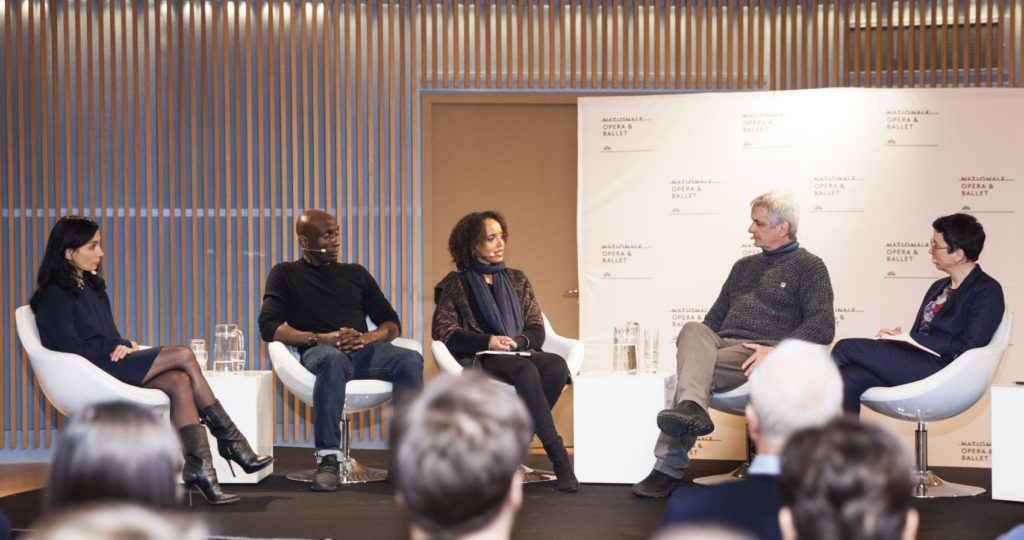 Duuvoort, herself black, has recognized the issues Howard had brought up. She related several experiences in which her color had been a problem to others. During her time at the Dutch National Ballet, she was repeatedly requested to paint herself lighter in order to fit into the corps de ballet, mainly when performing the classics or Balanchine pieces. She never did. The situation escalated in 1999 when she was being asked to do so during the break of “Swan Lake”. Duuvoort would not and was accused of refusing to work. She complained to the board and the workers’ council. Ensuing discussions were difficult, but Duuvoort never used a lighter make-up.
Duuvoort, herself black, has recognized the issues Howard had brought up. She related several experiences in which her color had been a problem to others. During her time at the Dutch National Ballet, she was repeatedly requested to paint herself lighter in order to fit into the corps de ballet, mainly when performing the classics or Balanchine pieces. She never did. The situation escalated in 1999 when she was being asked to do so during the break of “Swan Lake”. Duuvoort would not and was accused of refusing to work. She complained to the board and the workers’ council. Ensuing discussions were difficult, but Duuvoort never used a lighter make-up.
In the course of the talk she expressed her incomprehension about the discrimination against black dance culture. Examples of the black dance heritage are almost totally absent from the repertories of the big companies. In this context, Howard mentioned the disproportional value placed on ballet compared to anything else. Varied members of the audience also took up this issue.
Liburd, also black, danced in contemporary companies where he never faced such problems. It wasn’t an issue either during his time with the Scottish Ballet: “In the classics, there I was the father to a Japanese daughter.”
| McKenzie told about ABT’s “Project Plié”, which was launched in 2013 to diversify American ballet. “At the beginning I had problems confronting the issue because, frankly, I hadn’t seen dancers of color, specifically African-American or black dancers, at a level of training so that I would consider them for the company. So it wasn’t about the color, it was about readiness. […] We had to think how to improve access. Because in the end, people who haven’t been exposed to the art form, twenty-five-year olds who have never been to ballet, don’t just wake up one morning and go: Let’s go to ballet tonight!” Providing accessibility, finding talented children of color and enabling them to obtain professional training led to the outreach program “Project Plié”. |
As part of the project a ballet curriculum was developed to ensure a cohesive level and style of training; partnerships with regional companies and schools were established and support for teachers has been provided. Functioning for about four years now, McKenzie estimated that the number of black pupils enrolled is 7-8%. “We’re seeing more kids of color audition, the optic is changing.” Things will take time, but “the company looks markedly different in the last ten years. I do think we are ready to break the line. The white acts of ballets are not really about white people, they are about white tutus; they are about dead people.” McKenzie later added that for successfully putting diversity at the core of a company there has to be diversity on the board. It is a top-down process.
Project Plié addresses racial and ethnic diversity. Rojo suggested widening the spectrum: “What about learning disabilities, physical disabilities? Is it still possible to have someone in Manon pretending to be physically disabled?” English National Ballet started a program “Dance for Parkinson’s”, which isn’t meant as an offer to help Parkinson patients become active, but integrates them as artist into the company. Rojo is also patroness of the “Flamingo Chicks”, an initiative offering integrative ballet classes for ill and disabled children. Akram Khan’s recent “Giselle” for English National Ballet showed that diversity also matters in terms of commissioning a choreographer. It was the first time Khan had worked with a ballet company. Rojo summarized the cooperation as totally enriching.
Asked whether the language of ballet might also change by increasing diversity, Rojo said: “It has changed throughout the years. In the original works of the classical canon, male ballet dancers didn’t do anything. Then we absorbed traditional dances from Georgia, which revolutionized the technique of male dancing.” She mentioned how the dynamism and physical power of male Cuban dancers like Carlos Acosta changed the way the language is presented. “If we believe in our art form, if we believe the art form is strong enough to sustain change, then we have to embrace it. If we don’t embrace it, it is because we are not secure in our own art.” Rojo also raised the question whether the way classical technique is taught needs to be reconsidered, but she didn’t enlarge upon this intriguing issue.
Ashley Wheater gave a summary on how Chicago’s Joffrey Ballet deals with diversity: “The company reflects our city and our city reflects our company.” Diversity exist on all levels, he said. “We have a committee, a policy that we are very conscious of, for inclusion, for ethnicity, for equality.” Joffrey Ballet implemented regular training, called “Undoing Racism”, and the “Bridge Program”, a dance program for children aged eight and older, fully funded by the company. It also offers scholarships for study with the School of the Joffrey Ballet. Sixty-three African-American, Latino and Asian children are currently enrolled.
Spalding, having finally arrived from the airport, stressed the need of “having appetite for change” as imperative in order to reach a diverse audience. “You have to take that first, otherwise nothing will happen.” Spalding advocated innovations: “Whatever the 19th century heritage, the ballet world has to change, there is a trajectory for diversity now, it is gonna happen.” However, he confessed to not feeling hungry enough for truly radical change.
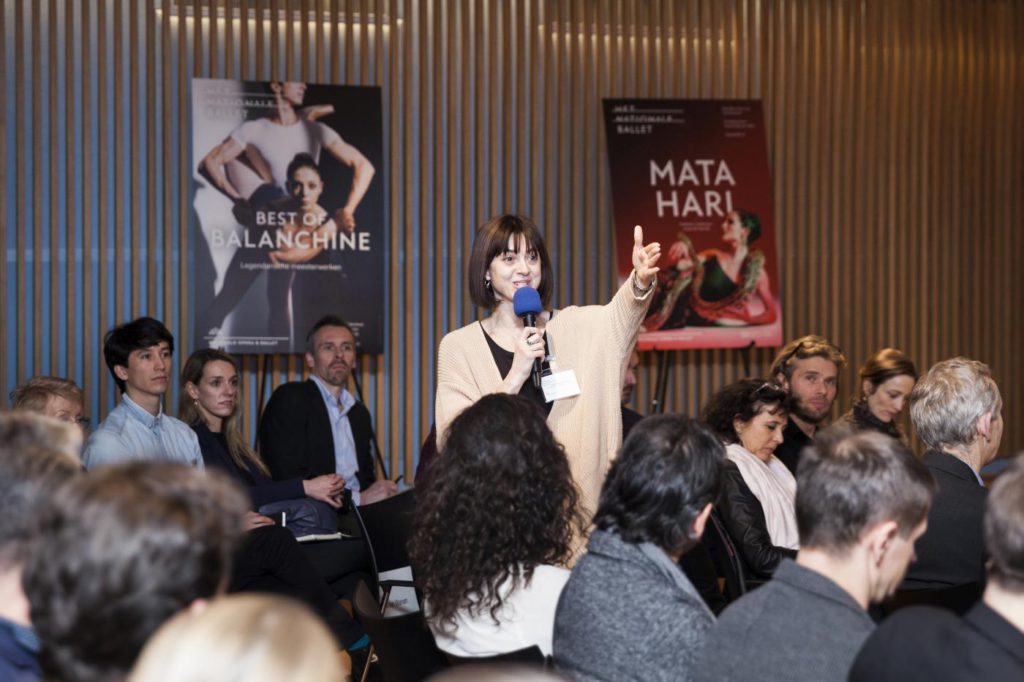 Identity
Identity
No introductory speech led into the last topic, Identity. Instead, there was a mini opinion poll on two questions: What defines a ballet company’s identity? and Who defines that identity? Nina Ananiashvili’s opinion was: “It is the choreographer.” Companies differ because of being shaped by certain choreographers. That is why she went to Copenhagen to learn Bournonville style and to London to work with Kenneth MacMillan. The people, talent, the repertory and education are crucial as well, but are secondary compared to the choreographer’s impact. The unity of choreographer and style is seen differently in Stuttgart, where John Cranko coined the phrase “Stuttgart Ballet has no style. We dance every style.”
The third panel consisted of Ted Brandsen, Laura Cappelle (Dance Critic and Researcher), Assis Carreiro (Independant Cultural Producer and Consultant), Karen Kain and Johannes Öhman. The audience’s contribution was major, many diverse topics were brought up, one comment leading to another. The debate began to meander and lack focus. That might have been due to a food coma but maybe Heritage, Diversity and Identity are topics so closely interconnected that discussions inevitably come to the same thing.
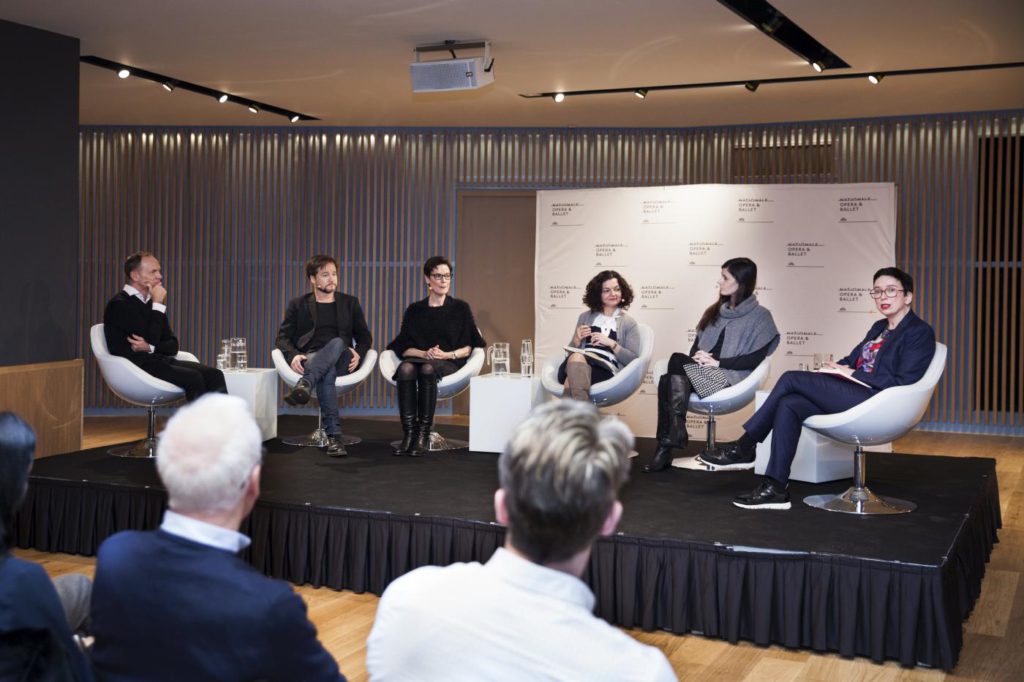 Again, there was talk about what constitutes the identity of a company: trust, a constant level of quality, political commitment – ultimately, seats have to be filled – and a balanced repertory, amongst others. Öhman pointed out that the amount of subsidy influences how far the repertory can be pushed. The Royal Swedish Ballet is in the luxurious position of getting an 80% subsidy, so Öhman can take risks. In fact, he said, he absolutely is obliged to do so. He struck a new path, for example, when adding contemporary dancers to his formerly fully-classical Swedish company. That both groups of dancers truly work together is important for him. Less so is that classical technique is polished day in, day out. One can always come back to the classical training when necessary, he explained. Brandsen had a different opinion. For his company, contemporary pieces are excursions, classical training has priority. “One has to go through first position, tendu and all that every day, because after a certain time away from the barre, one loses the technique.”
Again, there was talk about what constitutes the identity of a company: trust, a constant level of quality, political commitment – ultimately, seats have to be filled – and a balanced repertory, amongst others. Öhman pointed out that the amount of subsidy influences how far the repertory can be pushed. The Royal Swedish Ballet is in the luxurious position of getting an 80% subsidy, so Öhman can take risks. In fact, he said, he absolutely is obliged to do so. He struck a new path, for example, when adding contemporary dancers to his formerly fully-classical Swedish company. That both groups of dancers truly work together is important for him. Less so is that classical technique is polished day in, day out. One can always come back to the classical training when necessary, he explained. Brandsen had a different opinion. For his company, contemporary pieces are excursions, classical training has priority. “One has to go through first position, tendu and all that every day, because after a certain time away from the barre, one loses the technique.”
Cappelle pointed out that keeping the classics is important insofar as there is nothing to replace their role in the repertory. Choreographers capable of creating comparable pieces are very rare. Changes of the repertory reflect in the way the company dances and certain abilities are lost quickly. What would become of the corps de ballet, for example?
Rojo and Kain addressed management topics such as the practice of dialogue with the company and the need to share responsibility. A young choreographer of the Dutch Junior Company added that dancers are fairly silent artists. Usually they are not asked for their opinion. Hence they need to be encouraged to communicate. This led Rojo to mention a worrying issue, illiteracy. “It happens that I get dancers who can barely read or write and that is our fault. Because we teach them how to pirouette but not to read the books they are supposed to interpret later.” And, as the future choreographers often arise from the ranks of the dancers, the dancers’ training and education will ultimately effect the quality of choreographers of the future.
Greve pointed at another aspect of education, saying that due to technology and social media the young generation lives in a totally different world, of which the people in charge of the future of the companies have no idea. The first thing he did after taking over at the helm of the Finnish company was to research the behavior of Finnish people. He discovered, it turned out, that young Fins were absolutely uninterested in ballet. Hence, how to introduce them to this art form, how to stir and maintain their interest, became for him a basic task.
There was general agreement about the necessity of commissioning new work and nurturing choreographic talent with workshops or platforms such as Stuttgart’s Noverre Evenings for showing first attempts.
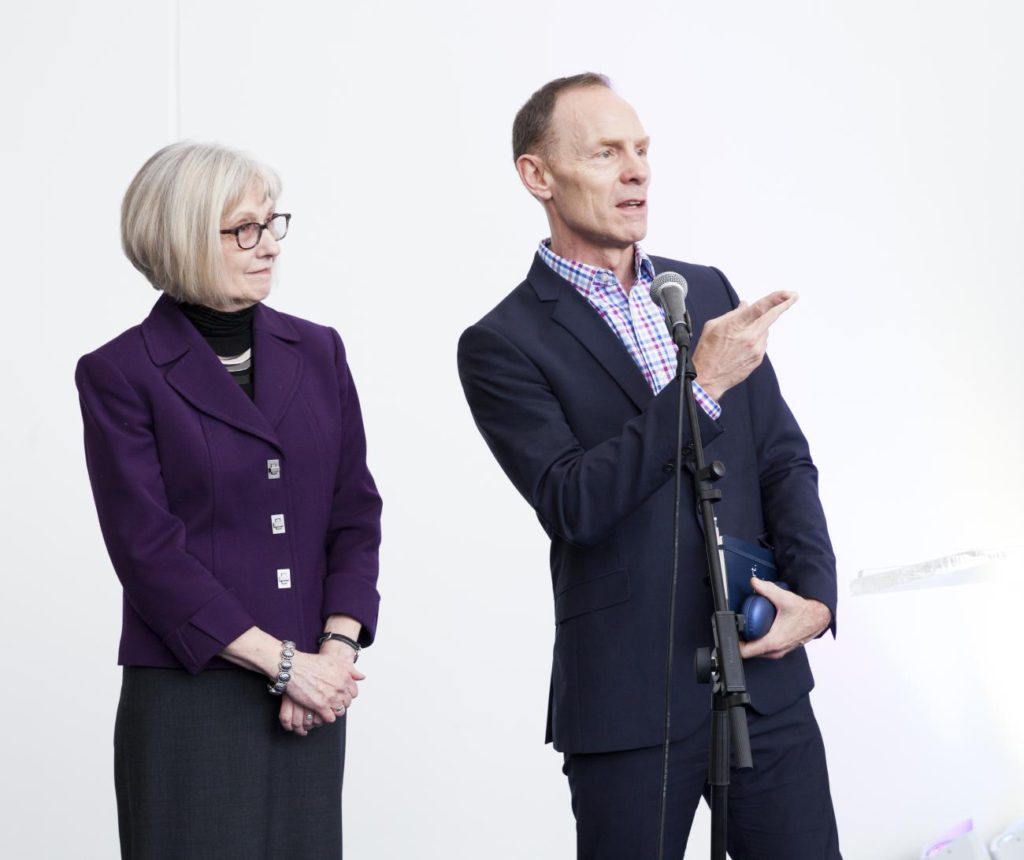 Looking into the Future
Looking into the Future
On Sunday, Valerie Wilder (Senior Arts Executive) talked about the European Dance Network she founded in 2016. It might serve as a model for initiating a more formalized networking of artistic directors. Wilder recently organized three meetings with administrative dance leaders at which the key topics of “Positioning Ballet” had also been discussed along with issues of co-productions, rentals, touring, dancer health, dancer transition, audience engagement plus contractual issues. These meetings proved to be valuable, so they will become institutionalized. Together with a pilot group, Wilder is examining options for developing a structure for regular sessions that will take relevant topics forward for the art form. “Dance USA is actually quite a good model and there is also a strong desire to keep a link with Dance USA. Particularly on certain topics. You all know that virtually all co-productions that are being undertaken at the moment often have a North-American partner.” Plans are for some artistic directors to join the pilot group and, perhaps, for also including representatives of professional dance schools.
The last talk was by Corinne Vigreux (Co-Founder and Managing Director of the consumer electronics company TomTom), who spoke about how to adapt to a world that is changing and, as she stressed, changing fast. What will keep the audience coming? How to deal with the shorter attention span of young visitors? Vigreux struck a blow for being inventive, for thinking out of the box and for taking risks. “Curiosity, innovation and bringing different cultures together is essential.”
For Brandsen this conference had been a first step: “We just started to touch upon some topics, to drop some words here and there and this was only the beginning of a conversation, which hopefully will allow us to grow.”
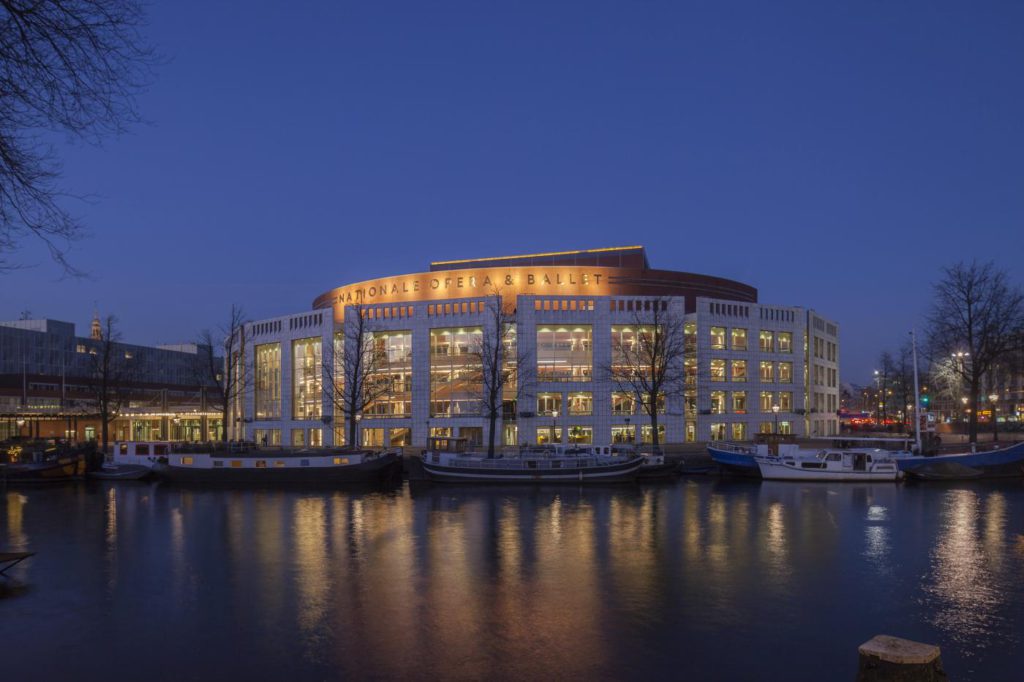
| Links: | Website of Dutch National Ballet | |
| Photos: | 1. | Participants of “Positioning Ballet”, Dutch National Ballet 2017 © Dutch National Ballet |
| 2. | Wiebke Hüster, “Positioning Ballet”, Dutch National Ballet 2017 © Dutch National Ballet | |
| 3. | Kevin O’Hare, Yuri Fateyev, Luísa Taveira, Krzysztof Pastor and Peggy Olislaegers, “Positioning Ballet”, Dutch National Ballet 2017 © Dutch National Ballet | |
| 4. | Kevin O’Hare, Yuri Fateyev, Luísa Taveira and Krzysztof Pastor, “Positioning Ballet”, Dutch National Ballet 2017 © Dutch National Ballet | |
| 5, | Theresa Ruth Howard, “Positioning Ballet”, Dutch National Ballet 2017 © Dutch National Ballet | |
| 6. | Ashley Wheater, Helgi Tomasson, Michaela DePrince, Kevin McKenzie and Monique Duuvoort, “Positioning Ballet”, Dutch National Ballet 2017 © Dutch National Ballet | |
| 7. | Tamara Rojo, Paul Liburd, Monique Duuvoort, Kevin McKenzie and Peggy Olislaegers, “Positioning Ballet”, Dutch National Ballet 2017 © Dutch National Ballet | |
| 8. | Nina Ananiashvili, in the background Nicholas Le Riche, right side: Kenneth Greve, “Positioning Ballet”, Dutch National Ballet 2017 © Dutch National Ballet | |
| 9. | Ted Brandsen, Johannes Öhman, Karen Kain, Assis Carreiro, Laura Cappelle and Peggy Olislaegers, “Positioning Ballet”, Dutch National Ballet 2017 © Dutch National Ballet | |
| 10. | Valerie Wilder and Ted Brandsen, “Positioning Ballet”, Dutch National Ballet 2017 © Dutch National Ballet | |
| 11. | National Opera & Ballet Amsterdam © Luuk Kramer | |
| Editing: | George Jackson, Laurence Smelser |
